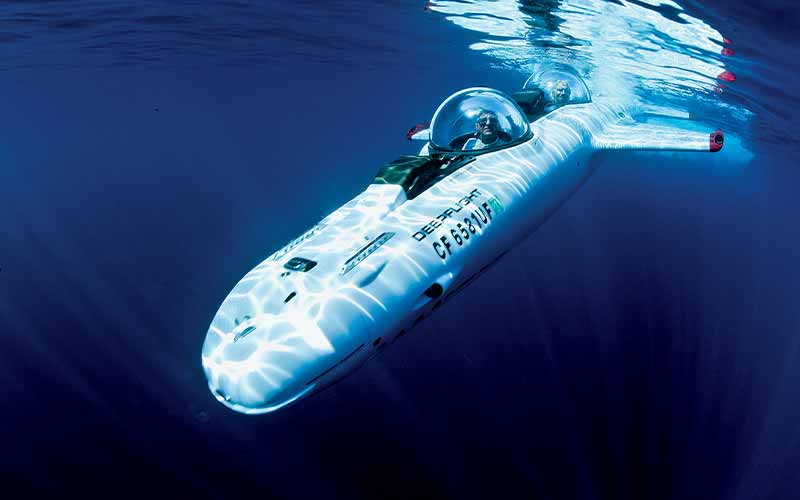Recently, on a great white shark expedition to Guadalupe Island, photographer Amos Nachoum received a radio call. It was submersible technology savant Graham Hawkes. He and Virgin Group chairman Richard Branson were in the neighborhood testing Hawkes’ new submersible, the DeepFlight Super Falcon, and they wondered if it would be OK to come cruise with the great white sharks around the boat where Nachoum was diving. It had to be a rather surreal experience for the group in the cage to see these two celebrity explorers cruising alongside 14-foot sharks in the crystalline depths of Guadalupe.
Hawkes described the experience from his perspective inside the sub: “We were there to train Richard Branson to fly the Super Falcon, and these were the first great whites we had seen, although I’m certain they were not the first ones to see us. We were a little nervous, not knowing if the sharks might view us as a bigger shark and want to challenge us to a territorial battle. But in the end it was a hell of a blast — two Englishmen flying underwater and sharing a passion for seeing big animals in their natural environment.”

The childlike excitement generated by the big animal encounters enabled by the Super Falcon is obvious in Hawkes’ voice as he describes a three-hour ballet with a manta ray and then later his stealthy approach from below of the resident hammerhead sharks that hang in the depths off Roca Partida in the Socorro Islands. In this case, venture capitalist and ocean enthusiast Tom Perkins shared the second canopy and the adventure as they cut the throttle and drifted in total silence toward the school.
Viewing big marine life in the twilight zone (as Hawkes calls the area beneath sport-diving limits but still illuminated by sunlight) is one of the principal reasons the Super Falcon was designed. Another compact submersible, the DeepFlight Challenger, was designed to dive 37,000 feet in the Mariana Trench and to the deepest points in the world’s other four oceans — a project now being undertaken by Deep Sub LLC in conjunction with Virgin Oceanic. The Super Falcon integrates many of the innovations of the Challenger prototype but is also positively buoyant and does not rely on traditional submarines’ lead weights or ballast to control depth. Hawkes makes the point that the only marine creature that operates like a conventional submarine in this regard is probably the chambered nautilus. Other ocean dwellers like sharks, manta rays and whales depend on fins for propulsion and direction. The Super Falcon likewise has wings and a propeller to emulate the speed, grace and agility of these big animals.
The ultimate advantage of the Super Falcon is that it is a serious submarine that can be launched from shore. There are several deep-ocean submarines operating at present, but they all require 300-foot support vessels that are national assets of the U.S., Russia, Japan or China and would cost $50,000 a day to charter. The Super Falcon can be launched from its own trailer and operate independently of a support vessel, consequently far more affordably.
The concept was validated in the spring of 2011 as the Super Falcon was deployed from beaches and marinas in the Gulf of Aqaba in the northern Red Sea. Seven of Jordan’s most respected scientists flew with Hawkes the entire length of the Jordanian coastline, from the Israeli to the Saudi borders. The objective was to investigate the corals beyond the 130-foot depths to which they had already been documented on scuba. The ability to navigate nearly 7 miles of coastline in a single dive and then hauling out on a remote beach is an entirely new concept in ocean exploration. By dispensing with the need for full-ocean-depth capabilities the DeepFlight Challenger requires, an ultralight submersible with speed, range and maneuverability became an operational possibility.
Of course, submarines like the Super Falcon are not cheap. The Christmas 2010 issue of the luxury goods chronicle Robb Report lumped Hawkes’ submersibles with rare desirables like the Bugatti Veyron in a cover story identifying 21 holiday gifts for the uber-wealthy. But with four generations of DeepFlight winged submersibles already developed, perhaps underwater flight will be an even more accessible reality one day soon. For more information, visit www.deepflight.com.
© Alert Diver — Q1 Winter 2012